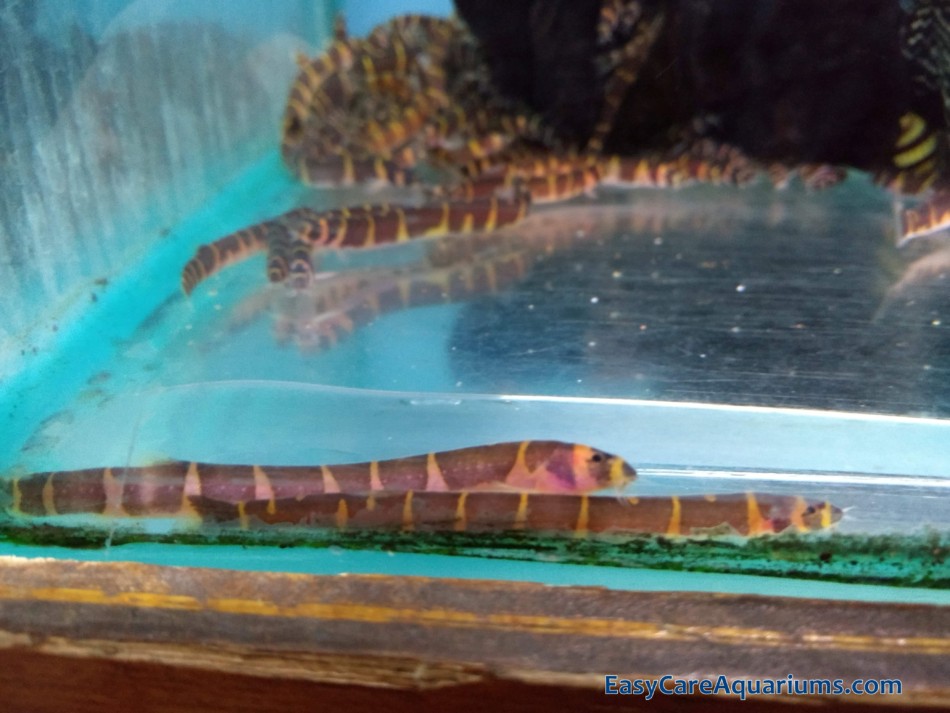This article may contain some affiliate links to products. The links provide me a small percentage of commission but do not cost you anything extra to use. (See full disclosure statement here ).
).
Kuhli Loaches are not fussy when it comes to mealtimes. Because they are omnivorous you have a wide range of foods to choose from which helps to make them an easy-care aquarium fish. .
You can feed your Kuhli Loaches with a combination of dried, frozen and live foods. Because the Kuhli Loach is predominantly a bottom feeder all foods need to be of the ‘sinking’ variety. Kuhli Loaches will also eat flake foods, Repashy gel and blanched green vegetables. Live insects in their larval stage, micro worms and small crustaceans are a firm favourite too.
Despite being a great scavenger fish, and a valuable member of an aquarium clean-up crew, the Kuhli Loach does need feeding in its own right.
The good news is that keeping your Kuhli Loaches well fed is easy to do.
Keep reading for some easy-care feeding tips and useful information.
What Should I Feed To My Kuhli Loaches?
Kuhli Loaches are also known as Pangio Kuhlii and Coolie Loaches. I have a neighbour that keeps them and she calls them tiger’s tails. But no matter what name you choose to call them by their dietary needs are the same.
In their native habitat of Southeast Asia the Kuhli Loach can be found in shallow freshwater forest streams and peat swamps. The water there is slow moving, shaded, and often tannin rich. And the Kuhli Loach will feed on whatever lives in, or falls into, the water. Basically they are an omnivorous scavenging fish that will take whatever food source is available at the time. They’ll even eat a little vegetation too.
Because they’re not fussy eaters in their native habitat Kuhli Loaches are easy to feed in the home aquarium. Which makes mealtimes easy for you, and enjoyable for them.
So let’s take a look at which foods you can feed to your Kuhli Loaches at mealtimes.
Flake Food For Kuhli Loaches
Although Kuhli Loaches will eat flake food it’s not the obvious choice when it comes to choosing what to feed them. The reason for this is that flake food takes a while to sink to the bottom of the tank and the vast majority of it gets eaten by their tankmates before it gets that far.
Kuhli Loaches will clean up any flake food that does make it to the bottom of the tank. But there’s no guarantee that they will get enough of it to make a decent meal. So when it comes to flake food it’s likely to be only a small part of their diet. That is unless you have a Kuhli Loach only tank of course.
Because Kuhli Loaches are a tropical fish you’re likely to be keeping them in a heated tropical tank. And if they have tankmates they’re likely to be tropical too. So flake foods that have been developed with the nutritional needs of tropical fish in mind are the ones to go for.
Sinking Foods For Kuhli Loaches
Sinking foods whether they come in pellet or wafer form are probably the best way to make sure that your Kuhli Loaches get enough to eat. Even if your Kuhli Loaches share a tank with other fish, shrimp and/or snails that will also nibble on the sinking food you’ll be giving your Kuhli Loaches the best chance to enjoy a good meal.
There are lots of different sinking foods for bottom feeders available. For example, Fluval, Tetra, and Hikari, all make sinking foods that are reputable and popular with fish keepers. They are also widely available at Pet Stores, Aquatic Dealers and Online. So it’s worth checking them out when you’re looking at which foods to feed to your Kuhli Loaches.
The Easy Way To Feed Insects To Your Kuhli Loaches
Kuhli Loaches love to eat insects. In their native environment insects, their larvae, and small crustaceans form an important part of their diet. The meaty protein they get from this type of food, along with other ‘meaty’ bits they can scavenge along the way, helps to keep them strong and healthy.
So although Kuhli Loaches do well on sinking pellet/wafer foods, they definitely benefit from being fed a little extra protein in the form of insects, worms and crustaceans.
Fortunately this doesn’t mean that you have to go foraging for bugs to feed to your fish.
There are lots of insects, worms and larvae available to buy in Pet Stores, at Aquatic Dealers and Online. These can be dried, frozen or live, depending on the type of bug and where you buy them from.
Here’s a few examples of insects/meaty protein that you can feed to your Kuhli Loaches (the links below take you to Amazon)
- Brine Shrimp
 (newly hatched/young ones)
(newly hatched/young ones) - Daphnia (a minute freshwater crustacean)
- Tubifex Worms (aka sludge worm)
- Bloodworms
 (often the worm-like larvae of midge flies)
(often the worm-like larvae of midge flies) - Mosquito Larvae (worm-like larvae of the mosquito)
Tip: If you choose to feed your Kuhli Loaches live foods make sure that you buy them from a reputable source. This helps to reduce the risk of contaminating your tank with pests and diseases.
If you prefer to feed your Kuhli Loaches insect/protein packed food in a dried granular form then it’s worth taking a look at the Fluval Bug Bites range. For my second feed of the day I’ve been feeding Fluval Bug Bites Tropical Formula Granules in my tanks and all the fish love it.
in my tanks and all the fish love it.

Feeding Vegetables To Your Kuhli Loaches
Vegetation forms a part of the Kuhli Loach’s diet in their native habitat. So treating them to some green vegetables is beneficial. Not only will they enjoy eating them but the veggies are good for their digestive system and overall health.
Some of the green vegetables you can offer to your Kuhli Loaches include:
- Courgette (Zucchini)
- Lettuce
- Cabbage (eg Savoy)
- Spinach
- Kale
You can try them with other vegetables too of course. Why not give Peas, Broccoli or Brussel Sprouts a go? You’ll soon get to know which vegetables they like and which they don’t. So it’s worth experimenting a little.
Note: Remember to remove any uneaten vegetables after a couple of hours so that you don’t foul up the tank with decaying food.
Tip: Soften The Vegetables First – To make the vegetables easy to eat, and enjoyable for your Kuhli Loaches, you need to soften them. You can cook them in a microwave, simmer, or steam them. Let them cool to room temperature before feeding them to your fish.
How Much Should I Feed My Kuhli Loaches?
You should feed your Kuhli Loaches at least twice a day. Feed them as much food as they can in eat within approximately 3 minutes or so with no leftovers. The only exception to this is when you treat them to some green vegetables. You can leave these in the tank for a couple of hours to allow them to ‘graze’ for a while. But make sure you remove the veggies from the tank once they’ve done with them.
An important thing to remember about the Kuhli Loach is that it’s basically a nocturnal fish. So making the last feed of the day just as you’re about to turn the lights off is a good idea. Check in the morning for any leftovers and remove them before you feed them some fresh food.
As with any other aquarium fish getting the amount of food right is a little trial and error at first. But after a while you’ll soon get to know when enough is enough.
Tip: An easy way to remove uneaten food from the bottom of an aquarium is to use a Turkey Baster. They’re cheap, widely available, and easy to use. Just remember to only release it’s contents once you’ve lifted it out of the tank.
Do Kuhli Loaches Eat Algae?
Kuhli Loaches are not known to be big algae eaters. So despite being valuable members of an aquarium clean-up crew, if you want to solve an algae problem in your tank Kuhli Loaches won’t be much help. They will eat Algae Wafers though. But this is probably because the wafers generally contain other things such as fish derivatives, fats and yeast as part of the ingredients.
Do Kuhli Loaches Eat Aquarium Plants?
Even though, in their native habitat, plant matter forms part of the Kuhli Loach diet they don’t generally eat aquarium plants. The main issue that some fish keepers experience with Kuhli Loaches and aquarium plants is that the Kuhli Loach sifts through the substrate in search of food. Unfortunately this can mean that the plants can sometimes be uprooted. So even though they may not eat the plants they can cause root damage which can lead to the plant dying off.
There are some easy solutions if you want to keep Kuhli Loaches and plants together, but want to avoid uprooting issues.
- Potted Plants – not all plants have to be planted into the substrate. Some plants will live in pots inside the aquarium. This means that they will not get uprooted by your Kuhli Loaches. I have a Bacopa plant that is thriving in a pot in one of my aquariums.
- Epiphyte Plants – this type of plant doesn’t need to be planted in the substrate. It can be attached to wood, rocks and plant decorations, and feeds through the water column not through a planted root system. Which means that Epiphyte plants can’t be uprooted by your Kuhli Loaches. I have Java Moss attached to rocks/pebbles in all of my aquariums.
- Artificial Fake Plants – there’s always the option of using artificial/fake plants. Some artificial/fake plants can look surprisingly real. And they don’t need any maintenance apart from the occasional wash if they get dirty. One of my fish tanks has a combination of live and artificial/fake plants and it works really well.
What Do Kuhli Loach Fry (Babies) Eat?
Kuhli Loaches can be difficult to breed in the home aquarium. But if you’re fortunate enough to be successful, and find you have some fry, feeding them isn’t too difficult. Kuhli loach babies will eat the same foods as their parents do. Although it’s best to make sure that the food is small and soft enough for them to manage. It also needs to be sinking food. But apart from that they are easy to please.


